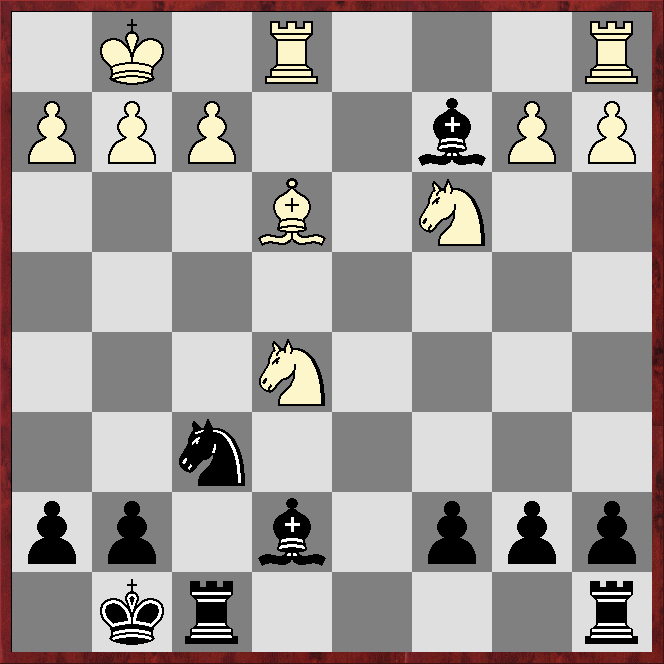IN round one of the Riviera afternoon open my opponent played the the sharp Schliemann Variation of the Spanish, which starts
1.e4 e5 2.Nf3 Nc6 3.Bb5 f5.The game continued 4.d4!? fxe4 5.Bxc6 dxc6 6.Nxe5, bringing about a position in which the players have very different assets.
 |
| Position after 6.Nxe5 |
Black has the bishop-pair on a relatively open board, and an advanced e pawn, which gives more space but is isolated and could prove vulnerable.
White has a knight on a central outpost that cannot be challenged by a black pawn. The knight is the only developed piece and, according to Siegbert Tarrasch's teachings, it should be counted as two development tempi since it has reached the fifth rank.
So the opening has determined that the game will be a battle of the bishop-pair, which, according to Larry Kaufman's Evaluation Of Material Imbalances, is on average worth a half-pawn, against White's lead in development.
The bishop-pair is usually thought of as a long-term asset, while a lead in development is usually short-term.
Theses are general considerations, and everything depends on specific moves, with, in this case, a major complication in the status of the e pawn.
The full game can be seen
here, but in this post I want to present a series of snapshots of how play developed, with the focus being on bishops versus development.
 |
Position after my apparent novelty, 11.Bg5-e3 - both players have castled, and White has developed a rook and three minor pieces, one of which is a knight on the fifth rank; Black has also developed a rook and three minors, and so has almost caught up in development (Komodo14.1 gives Black a slight edge, while Stockfish16 gives Black the better side of equality)
|
 |
| Black has played a mini-combination, exchanging the advanced but isolated e pawn for the white c pawn, gaining a farside pawn-majority into the bargain - the price is that White will develop the queen's rook with tempo by playing 15.Rac1 (the engines reckon the game is completely equal) |
 |
| Position after 18.Be3-g5 - Black has retreated the light-square bishop to the back rank to preserve the bishop-pair, giving White a large lead in development but with no obvious targets for exploiting the lead (the engines reckon the position remains balanced) |
 |
| Position after 26.Rd1-d2 - a flurry of exchanges has brought about an ending in which Black has the bishop-pair and a farside pawn-majority, and he would be slightly better after completing development with 26...Re8 (the a7 pawn is poisoned) |
 |
| Position after 33.Be3-f4 - Black still has not developed the queen's rook, and the bishop-pair has been forced to the back rank, but bishops are long-range pieces and are not especially inconvenienced by this |
The engines reckon Black would gain a slight edge, or at least have the better side of equality, by developing the rook via a7 and d7.
Instead the game saw 33...Bb7?, after which 34.Nxb6! Bab6 35.Rd7+ won a pawn and got rid of the bishop-pair (1-0, 58 moves).
LESSON: the bishop-pair is a powerful weapon, quite possibly worth a pawn on an open board with rival pawn-majorities. But a lead in development is also a powerful weapon, especially in the unusual circumstances of this game, where the lead was maintained into an ending, meaning the possibility of a tactical coup was ever-present.






No comments:
Post a Comment